When I peaked out the window of our room this morning I was delighted to see Mt. Fuji clearly outlined against the blue sky. We had caught a bit of a glimpse during dinner last night, and the sky turned orange and yellow and pink around the peak of the mountain. But the view this morning literally would take your breath away, so we quickly dressed and set off for a walk to the nearby Oshi Park, which would have a clearer view from a different angle. It was simply gorgeous. Some clouds wafted by and the lake was like glass so the reflection added to the beauty. And the red torii gate of the nearby shrine added color to the blues and greens of the natural setting. We were told that to see Fuji that clearly is good luck, so we will take it as an auspicious sign.




Then it was off to Narita Airport, by way of shuttle van to the train station and two trains. I sit now in the lounge with several hours to wait until my flight to Hawaii, so I will reflect here about the culture of Japan.
First, of course, would be the food. Always presented as art, and on many small decorative plates, it was beautiful and yet sometimes challenging. Some items weren’t easy to identify and others simply were too alien for me, but it was impossible not to appreciate the presentation and the quality whether spending $7 or $170. I may avoid ramen for awhile though.
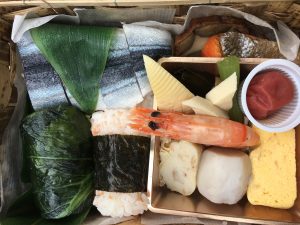


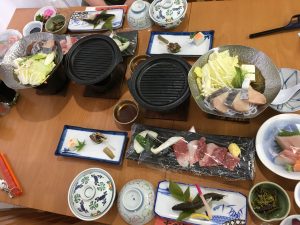
In many of the towns visited, the manhole covers were decorative — reflecting something about the place. Deer in Nara, cranes at Himeji and many with fire trucks, which I think were designated as where the “fire hydrant” was located.




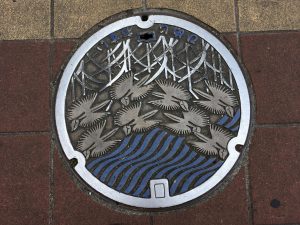

The trains were so efficient, and most very comfortable to ride. We had some local commuter/subways which got as crowded as any train would, but the passengers were all so unfailingly polite that it didn’t seem as uncomfortable. Many of the larger stations involved what seemed like miles of tunnels and connection corridors, but we never got on the wrong train, and only missed one connection. The bullet trains are incredibly fast, and everything seems to run on time. And at some stations the personnel bow or wave goodbye as the train pulls out of the station. Some of the signs identifying which car would stop there were a bit confusing, which was important to know because of cars with reserved seats, but eventually we figured those signs out too.



The ryokan experience I’ve already noted, but I hadn’t noticed all the futons hanging from balconies everywhere, with big giant plastic clips to hook them to the railing. I suspect they get aired out this way, but I can’t imagine having to make and unmake beds like that everyday.

Given the number of tourists that come to Japan, there were many signs in English, even in the smallest town. Many would use graphics to tell the warning, others had strange translations, but I was so grateful to have the English to help guide and provide information about places.
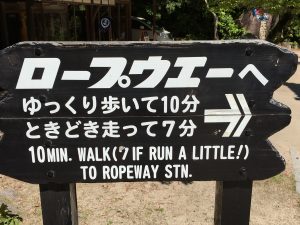
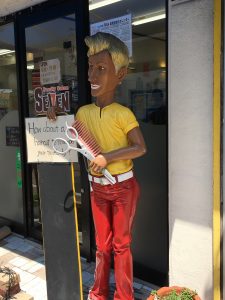




Recycling is a big part of the culture, and even at Starbucks there are 4 different bins in which to sort your trash. I was more intrigued by the been cans which were cut and folded into different shapes, and soda bottles made into little colorful wind ornaments. There is absolutely NO TRASH anywhere on the streets or the trains; it is expected that if there isn’t a bin people will take their garbage along with them. Very few restrooms had paper towels and dinner napkins were small if at all. It is considered wasteful. So people carry their own little hand towels with them, and use the damp oshibori at the beginning or end of the meal for messy hands.

And now I must talk about the toilets. No photos, but clearly Toto has the monopoly. Their popularity stems form Japan’s love of cleanliness and its maxim “The restroom is the face of the household”. Every restaurant, museum, hotel and even parks are fitted with these toilets that have so many functions it’s difficult to know which button does what. There are front and back bidets, water pressure, bowl water temperature, heated seats, and sound effects or music to mask personal noise. Some even have air driers for post-bidet use and automatic lid opening and closing. Which can go a bit haywire if you use the bathroom mirror for any length of time.
Most every group of children we saw were in uniform, most with hats as well as skirts or shorts and some even had matching backpacks. They were all very well behaved, and many would say hello when walking past. We caught several groups at the Children’s Peace Memorial in Hiroshima, all there for field trips.


The parking spots in lots and on the street were interesting, with a locking feature that I guess prevents leaving without paying. I didn’t see how they worked, but they were ubiquitous.

Lastly, and reflected pretty much in all of the above was how very polite the people are. Everyone is greeted when entering a store or a restaurant or even when buying a ticket with irasshaimase — a sort of welcome — usually with a short bow. When walking through a crowded area, people would hold their hands vertically in front of them and say sumimasen. And every thank you seemed very genuine. With 127 million people in a land slightly smaller than California (with a population of 39 million), you’d think we might be able to clean up the streets and our behavior towards one another a bit better. The true Japanese maxim seems to me to be kindness and respect. For each other, and for nature.
I have only had 4 weeks here, and I believe one could spend half a year here and still not see all the beautiful places or experience all that this lovely country has to offer.
And so ends this blog. For now. The “An Epic Adventure” chapter is closing, until my next journey. Thanks for traveling along with me.
